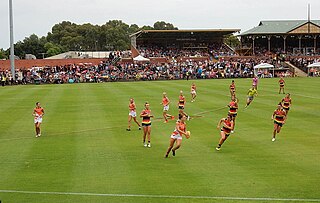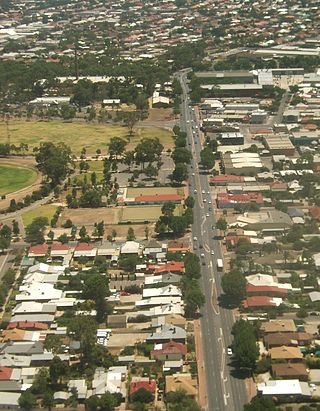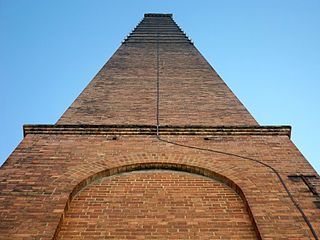Related Research Articles

A brickworks, also known as a brick factory, is a factory for the manufacturing of bricks, from clay or shale. Usually a brickworks is located on a clay bedrock, often with a quarry for clay on site. In earlier times bricks were made at brickfields, which would be returned to agricultural use after the clay layer was exhausted.

Torrensville is a western suburb 3 km (1.9 mi) west of the centre of Adelaide, South Australia. It was named after Irish-born economist and chairman of the South Australian Colonisation Commission, Robert Torrens.

Thebarton, formerly Theberton, on Kaurna land, is an inner-western suburb of Adelaide, South Australia in the City of West Torrens. The suburb is bounded by the River Torrens to the north, Port Road and Bonython Park to the east, Kintore Street to the south, and South Road to the west.

The City of Charles Sturt is a local government area in the western suburbs of Adelaide, South Australia, stretching to the coast.

Brompton is an inner-northern suburb of Adelaide, South Australia in the City of Charles Sturt.

Croydon is a single-member electoral district for the South Australian House of Assembly. Named after the suburb of Croydon, it is a 18.78 km2 (7.25 sq mi) suburban electorate in Adelaide's inner north-west. In addition to Croydon, it includes Angle Park, Athol Park, Bowden, Brompton, Croydon Park, Devon Park, Dudley Park, Ferryden Park, Kilkenny, Mansfield Park, Regency Park, Renown Park, Ridleyton, West Croydon, Woodville Gardens; and parts of Allenby Gardens, Welland, and West Hindmarsh.

West Torrens is a single-member electoral district for the South Australian House of Assembly. Named after the City of West Torrens, it is a 25.1 km² suburban electorate in Adelaide's west. It includes the suburbs and areas of Brooklyn Park, Cowandilla, Flinders Park, Hilton, Hindmarsh, Keswick Terminal, Marleston, Mile End, Mile End South, Netley, Richmond, Thebarton, Torrensville, Underdale and West Richmond, as well as parts of Allenby Gardens, Lockleys, Welland and West Hindmarsh.

Mile End is an inner western suburb of Adelaide, located in the City of West Torrens, around 2 kilometres from the Adelaide city centre. It has a census area population of 4,413 people (2011). Much of the suburb is residential, but there are small commercial areas along Henley Beach Road and South Road.

Marston Vale is an area of Bedfordshire. It lies to the south west of Bedford and Kempston, near Junction 13 of the M1 motorway. Historically it was one of the main brickmaking districts in England, home of the London Brick Company, now a division of Hanson plc. The brickmaking activity left scars across the landscape of the Marston Vale as large tracts of land were dug for clay. Most of the claypits are now exhausted, and most of the brickmaking chimneys have been demolished. The legacy of the abandoned brickworks also adds to the impression that the Marston Vale has been despoiled by decades of industrial activity and it is now searching for a new identity. In more recent years the local authorities have taken the opportunity to reuse the clay pits for landfills at Stewartby and Brogborough, both of which are recently capped and closed down.

The South Australian Brewing Company, Limited was a brewery located in Thebarton, an inner-west suburb of Adelaide, South Australia. It is a subsidiary of Lion, which in turn is owned by Kirin, a Japan-based beverage company. It manufactures West End Draught beer.

The Hoffmann kiln is a series of batch process kilns. Hoffmann kilns are the most common kiln used in production of bricks and some other ceramic products. Patented by German Friedrich Hoffmann for brickmaking in 1858, it was later used for lime-burning, and was known as the Hoffmann continuous kiln.

Thebarton Oval is a sports ground in Adelaide, South Australia currently used for a variety of sports including Australian rules football. It was the home ground of South Australian National Football League (SANFL) club West Torrens between 1922 and 1989, and since 2008 has been the home of the South Australian Amateur Football League (SAAFL) now called the Adelaide Footy League.

Welland is an inner suburb of Adelaide in the City of Charles Sturt local government area. It is around 5 km west northwest of the city centre. It was named for Welland, Worcestershire in 1907.

West Hindmarsh is a suburb of Adelaide, located in the City of Charles Sturt local government area. It is around 4 km west northwest of the Adelaide city centre. It is bounded on the south by the River Torrens, east by South Road, north by Port Road and west by streets separating it from the suburb of Welland which has the same north and south boundaries. Grange Road crosses the middle of the suburb.

Charles Willcox was an Australian businessman and politician. He was Mayor of Adelaide from 1892 to 1894, was briefly a member of the South Australian House of Assembly for Gumeracha in 1896, and was a member of the South Australian Legislative Council for North-Eastern District from 1897 to 1902.
Bradley & Craven Ltd was a manufacturing company specializing in brickmaking machinery in Wakefield England. It was founded in 1843 by two young engineers, William Craven and Richard Bradley to manufacture what was then revolutionary machinery for automating clay brick production. Their 1853 patented ‘Stiff-Plastic Brickmaking Machine’ in combination with the Hoffman continuous kiln were responsible for changes in the industry which eventually saw a shift from hand craft to mechanized production. Their machines were manufactured at the Westgate Common Foundry in Wakefield and were sold throughout the United Kingdom as well as many oversees markets such as Australia, South Africa and Germany.

Newmarket Brickworks Chimney is a heritage-listed brickworks at 117 Mina Parade, Alderley, City of Brisbane, Queensland, Australia. It was built in 1912. It is also known as Hoffman Stack. It was added to the Queensland Heritage Register on 24 March 2000.

Thomas Henry Brooker was a politician in colonial South Australia. He was a member of the South Australian House of Assembly from 1890 to 1905, representing West Torrens (1890–1902) and Port Adelaide (1902–1905). He was Minister for Education and Minister for Industry in the Jenkins ministry from May 1901 to March 1902.

The Town of Thebarton was a local government area of South Australia from 1883 until 1997. It was seated at the village of Thebarton, now an inner west suburb of Adelaide.

The Town of Hindmarsh was a local government area in South Australia from 1874 to 1993, encompassing on the inner north west Adelaide suburbs of Hindmarsh, Bowden and Brompton.
References
- ↑ Nick Gould Family History accessed 16 February 2011
- 1 2 3 4 5 Death of Mr Job Hallett The Advertiser 1 November 1940 p.19 accessed 15 February 2011
- 1 2 3 4 5 6 Payne, Pauline (1996). Thebarton: Old and New. Thebarton City Council. p. 76–77, 108, 182. ISBN 978-0-646-30157-0 . Retrieved 7 October 2021.
- 1 2 3 4 5 6 7 "J. Hallett & Son Limited: Summary record". State Library of South Australia . 24 January 2017. Retrieved 7 October 2021.
Hallett Brick Industries Ltd. Clay Brick Manual, comprising clay brick catalogues, information on the company and how to use the products, pricelist, and dimensions, 1976...
- 1 2 City of Adelaide; Department for Environment, Heritage and Aboriginal Affairs (April 1998). "Early bricks and brickwork in South Australia". Heritage Conservation Practice Notes. Technical Note. ISSN 1035-5138.
September 2008: Published online with revised contact details: Department for Environment and Heritage 2008
- 1 2 Anthony Moore, Brickmakers in South Australia 1836–1936, Department of Architecture (Working Paper No. 8), University of Adelaide, 1981, pp. 135–144
- ↑ Sutton, Malcolm (6 August 2021). "Crowds return for SANFL as the Brickworks kiln is flagged as new grand finalists tower". ABC News. Australian Broadcasting Corporation . Retrieved 5 October 2021.
- ↑ "Nubrik House" (PDF). hoddle grid heritage review. 2019.
- 1 2 3 Denisbin (22 March 2017). "Adelaide. Torrensville". Flickr. Retrieved 7 October 2021.
- ↑ "HALLETT NUBRIK, An Australia Trademark of Nubrik Pty Ltd. Application Number: 434803". Online Trademark Registration. 17 October 1985. Retrieved 7 October 2021.
- ↑ McKay, Beverley (6 July 1989). "Adelaide industrial sale defies caution to be biggest of year". Australian Financial Review . Retrieved 7 October 2021.
- ↑ "About Austral Bricks". Austral Bricks. Retrieved 7 October 2021.
- ↑ Keam, Patrick; McLauchlan, Cathryn (2 June 2017). "Look at Adelaide's favourite old chimney now". adelaidenow. p. 22. Retrieved 6 October 2021.
- ↑ Death Notices The Advertiser 28 October 1940 p.8 accessed 15 February 2011
- 1 2 Littlehampton Brick Ltd. The Advertiser Friday 7 September 1945 p.2 accessed 17 February 2011